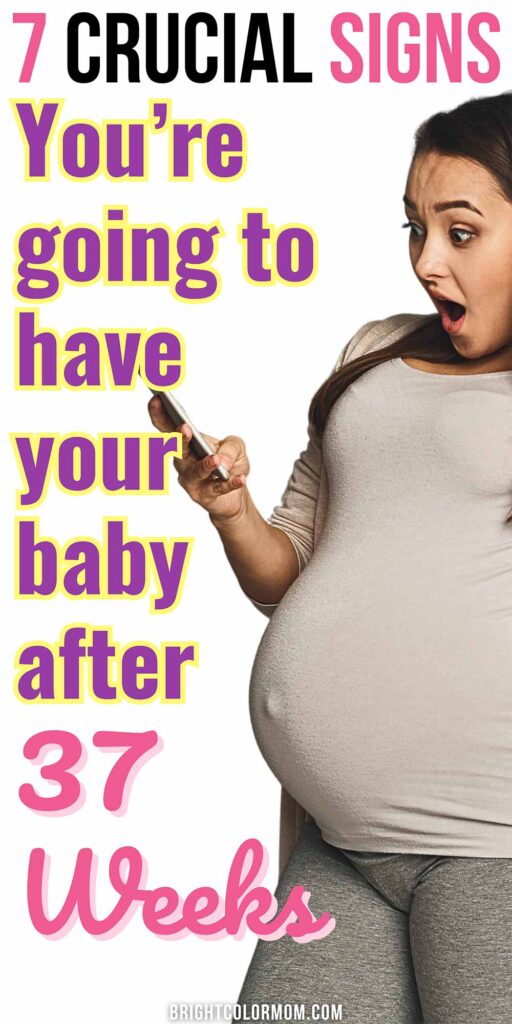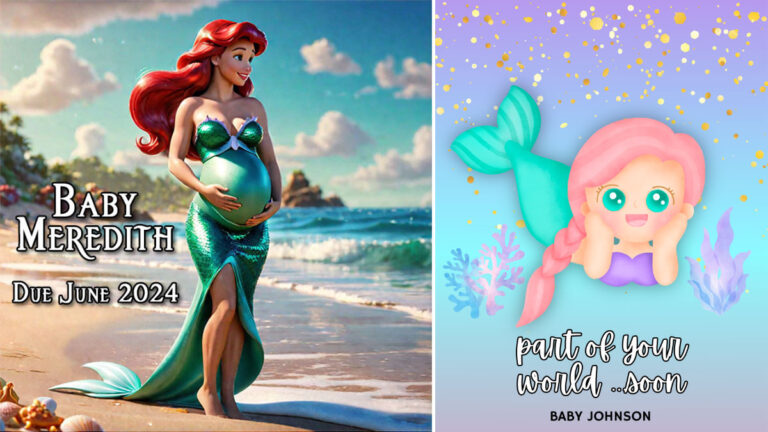It’s the home stretch, and you’re about to be a mom! You’re waddling around wondering if this baby is EVER going to come out, and probably a little nervous about giving birth. Just know that birthing anxiety is totally normal, but women have been doing it for millennia, so you can too!
Choose Your Week
- Pregnancy Week 37
- Pregnancy Week 38
- Pregnancy Week 39
- Pregnancy Week 40
- Pregnancy Week 41
- Pregnancy Week 42
Sources of information included in this series include What to Expect, American Pregnancy Association, several specific sources cited within the text, and my personal experience as a biological mother of two!
Pregnancy Week 37 Development
How many months pregnant is 37 weeks?
37 weeks equals eight-and-a-half months pregnant! I highly recommend you read my advice to newborn moms to be better prepared before bringing your baby home.
Where is the baby located at 37 weeks?
Virtually all babies are head-down at this point, and if you haven’t experienced the lightening (dropping) yet, this might be the week! How will you know if the baby has dropped? It’ll feel a bit like a bowling ball has firmly nestled into your pelvis, especially when walking up flights of stairs.
What does a baby look like at 37 weeks?
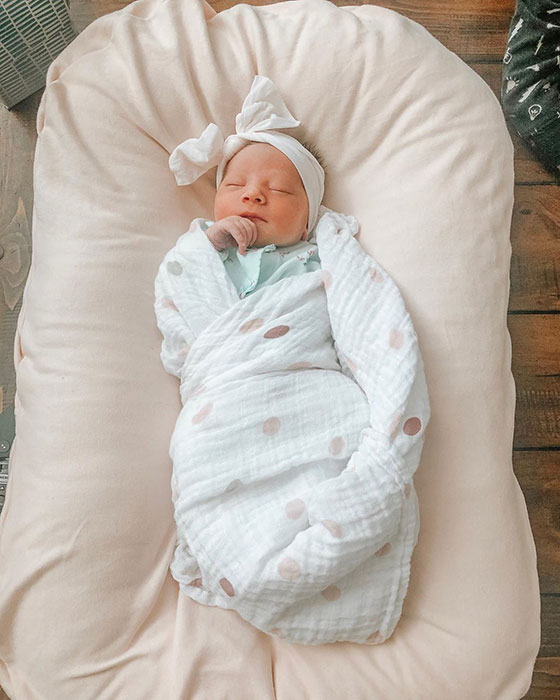
- Average fetal length at 37 weeks: 18 inches
- Average fetal weight at 37 weeks: 6.5 pounds
Those fingers are more agile, and the baby can now grab small objects like its own nose or individual toes. The lungs should be fully developed about now, but that doesn’t mean the baby should come out just yet if you can help it; the longer that bun stays in the oven, the less the baby’s at risk for illness or medical problems.
Baby’s probably sucking its thumb a lot and should use that skill to take to feeding right away. I strongly recommend having pacifiers on hand after birth, even if you breastfeed exclusively. If you notice the baby continues its thumb-sucking habit after birth, you should replace its thumb with the binky instead. Why? As the baby gets older and needs help to break the habit (most babies do), you can take away a pacifier, but you can’t get rid of the thumbs!
Pregnancy Week 37 Symptoms & Baby Bumps
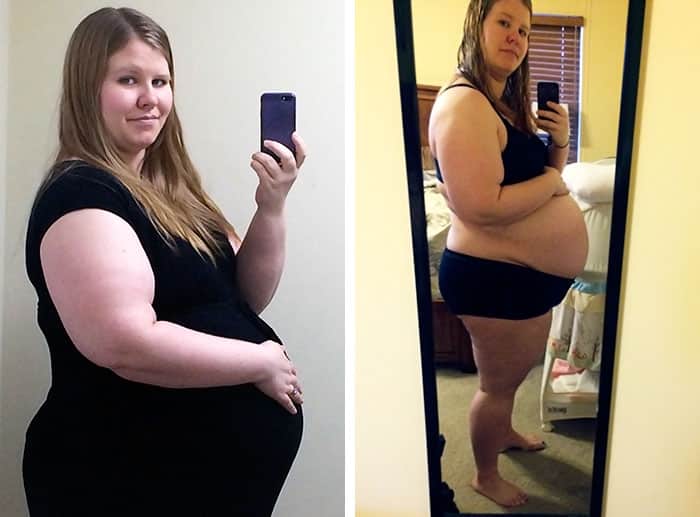
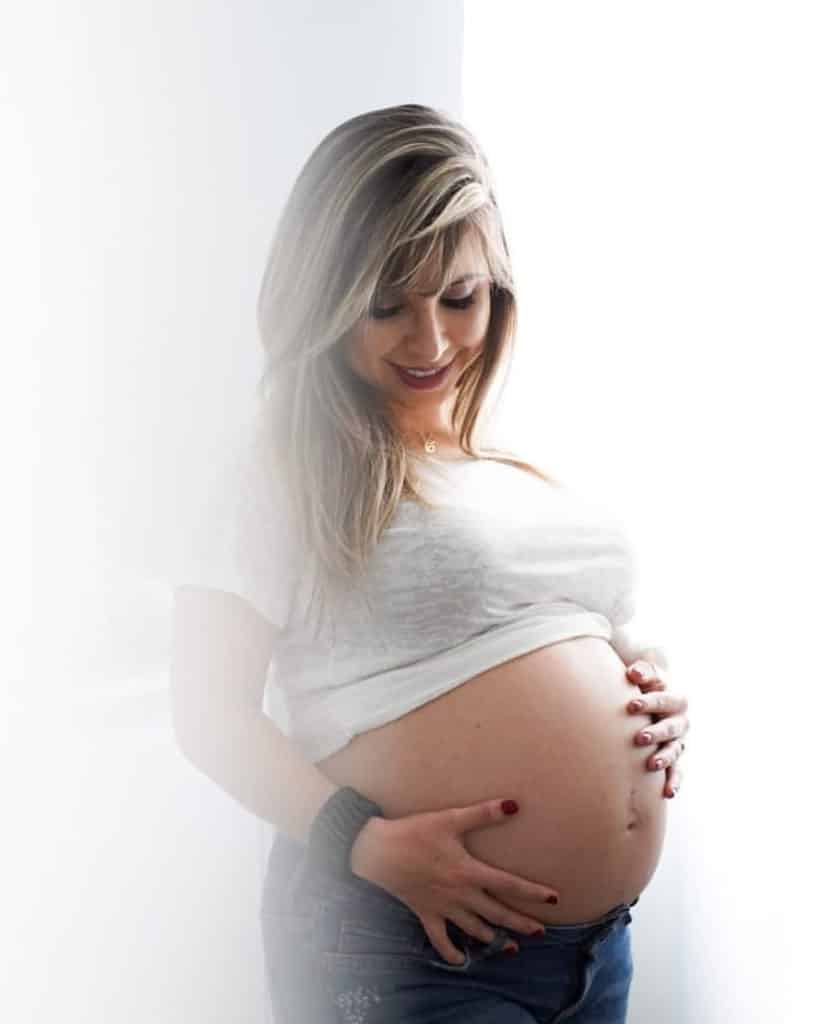
When you start dilating, evidence may show up in the form of a bloody show, the term for a blob of pink or brown mucous that’s discharged due to blood vessels in the cervix rupturing. It may look scary, but it’s actually exciting; this means your body is getting ready for the big event!
Your nipples may be preparing themselves as well: you may notice them standing at full attention most of the time, and they may look larger than normal (good news for baby’s hungry mouth!).
Here’s a question many women have: If you have preeclampsia at 37 weeks, will they induce labor? Well, that depends on how severe your preeclampsia is. Sometimes, bed rest and antenatal corticosteroids will get you a couple more weeks of pregnancy. But if your symptoms are severe, or you developed preeclampsia earlier in your pregnancy, the baby might be safer on the outside of the womb than the inside – and you will be, too.
Continuing symptoms:
- food cravings
- heartburn
- gas
- vaginal discharge
- constipation
- dizziness
- increased OR decreased sex drive
- varicose veins
- round ligament pain
- increased mucus and oil production
- sensitive gums
- forgetfulness
- stretch marks
- backaches
- leg cramps
- swelling
- fast-growing hair and nails
- Braxton-Hicks contractions
- skin discoloration
- altered vision
- hemorrhoids
- insomnia
- fatigue
- leaky breasts
- frequent urination
- nesting
Pregnancy Week 37 Video
Pregnancy Week 38 Development
How many months pregnant is 38 weeks?
38 weeks equals almost nine months pregnant!
Where is the baby located at 38 weeks?
Baby should’ve shifted to head-down by this point, and should be staying there, both because it’s ideal for birth (both vaginal and c-section) and because there’s just not enough room to turn around anymore. If the baby is still breech at 38 weeks, it’s highly unlikely it’ll be able to turn over on its own – there’s just not enough room for it to happen naturally.
If conditions are right (baby has a good heartbeat, you have no other risk factors, and your uterus is pear-shaped), your doctor may recommend an external cephalic version. In this non-invasive procedure, the doctor literally tries to push your baby to a head-down position. If you don’t like this idea, your best bet is a scheduled c-section.
What does a baby look like at 38 weeks?
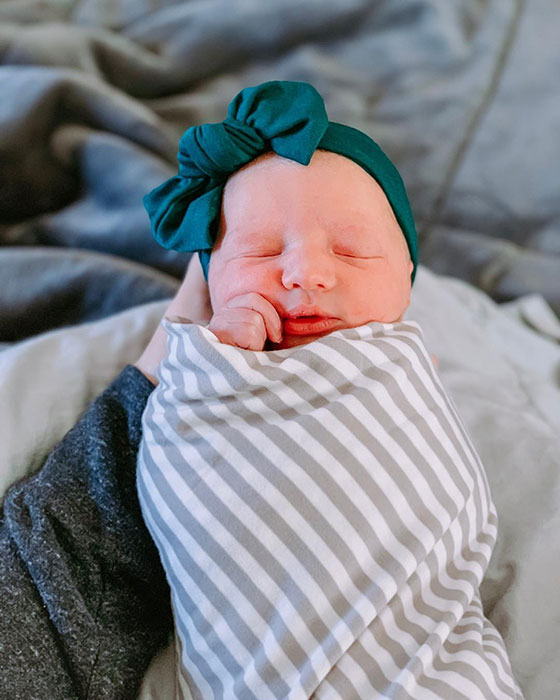
- Average fetal length at 38 weeks: 18.5 inches
- Average fetal weight at 38 weeks: 7 pounds
If you’re white, your baby will likely be born with blue or grey eyes – but they might not stay that way (unless both biological parents have blue eyes). Eye color can change for up to a year while the given pigment takes hold of the baby’s irises. Babies of color can be born with blue or grey eyes, but are often born with dark eyes that remain the same color.
The fine hair (lanugo) that grew all over the baby’s body has almost completely fallen out now (though many babies still have some on their foreheads, shoulders, and backs, even at full-term birth). The lungs should be strong now, and the vocal cords well-developed, making the baby ready to cry upon womb exit!
Pregnancy Week 38 Symptoms & Baby Bumps
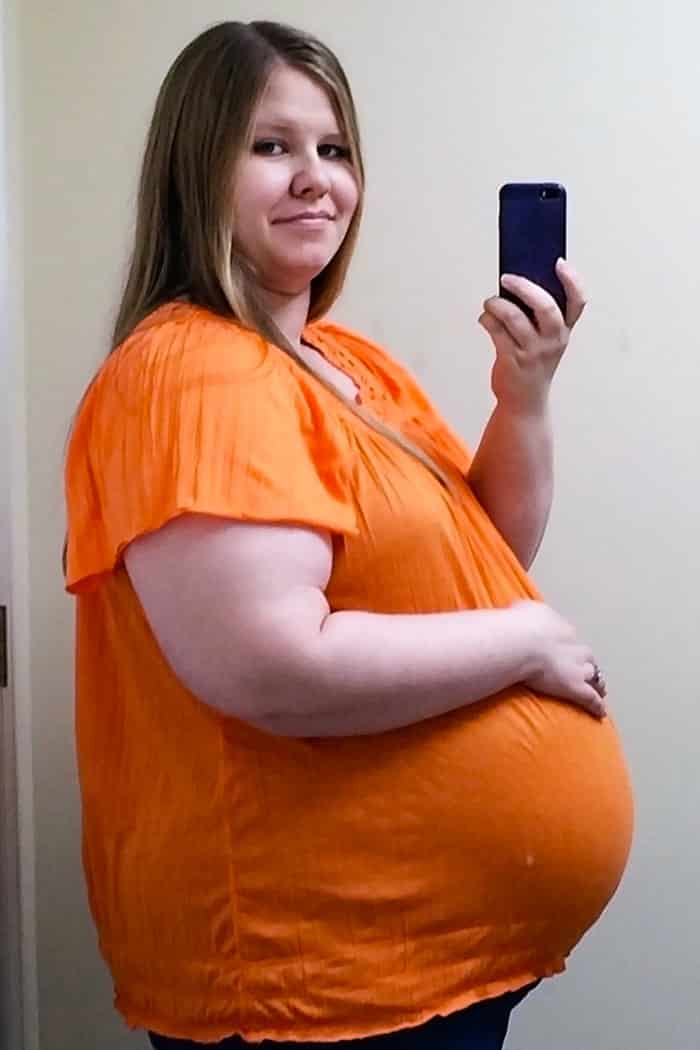
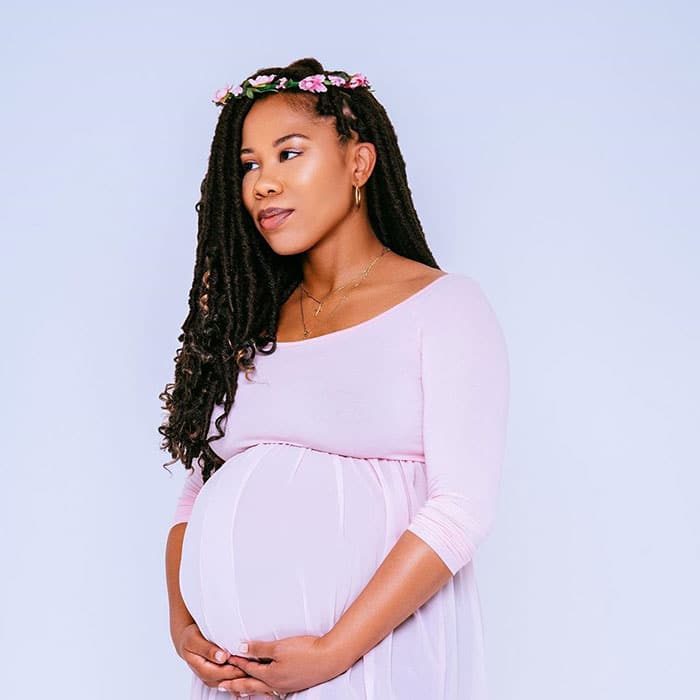
If the bloody show isn’t fun enough, you may have the joy of passing your mucous plug soon. It’s as gross as it sounds: it’s a big glob of goo (that may be blood-tinged) that has been acting like a protective plug in your cervix. While it doesn’t mean labor is imminent, you could be at increased risk of infection without it, so you should tell your doctor if you notice this blob in your underwear.
Another fun sign that labor is about to start: diarrhea! It’s your body’s way of clearing everything out so the baby has plenty of room to wiggle its way out. If diarrhea starts up, you can take it easy on the fiber, but keep drinking plenty of water.
Preeclampsia is a serious condition that often presents after delivery, but can happen at any point in pregnancy (most likely after the fifth month, with increased risk in each passing week). Even if you’ve been in the clear until now, preeclampsia can show up quickly, which means it’s one of the things your doctor is checking for at your weekly appointments. Learn more about preeclampsia symptoms – early detection is key to a safe delivery.
Also, if you believe you are leaking amniotic fluid at 38 weeks, you need to contact your doctor ASAP. Too much fluid loss before delivery can be very bad for the baby!
Continuing symptoms:
- food cravings
- heartburn
- gas
- vaginal discharge
- dizziness
- increased OR decreased sex drive
- varicose veins
- round ligament pain
- increased mucus and oil production
- sensitive gums
- forgetfulness
- stretch marks
- backaches
- leg cramps
- swelling
- fast-growing hair and nails
- Braxton-Hicks contractions
- skin discoloration
- altered vision
- hemorrhoids
- insomnia
- fatigue
- leaky breasts
- frequent urination
- nesting
Pregnancy Week 38 Video
Pregnancy Week 39 Development
How many months pregnant is 39 weeks?
39 weeks equals nine months pregnant!
Where is the baby located at 39 weeks?
Hopefully head down, facing your pelvis, and dropped squarely next to your birth canal, the baby doesn’t really have anywhere else to go at this point. Your body is runnin’ out of room and the baby keeps packing on fat, so things are getting pretty snug. It’s normal for the baby to move less and less the closer to your due date you get, but if you don’t notice any movement for several hours and can’t get the baby to move with pokes or cold apple juice, you should call your doctor.
My first baby barely moved at all the last couple of weeks unless I pushed hard on her butt (and she’d finally try to kick me), and it wasn’t just because of a snug womb. Her amniotic fluid wasn’t being replaced fast enough to keep an adequate supply, so her environment was literally shrinking right before she was cut out.
What does a baby look like at 39 weeks?
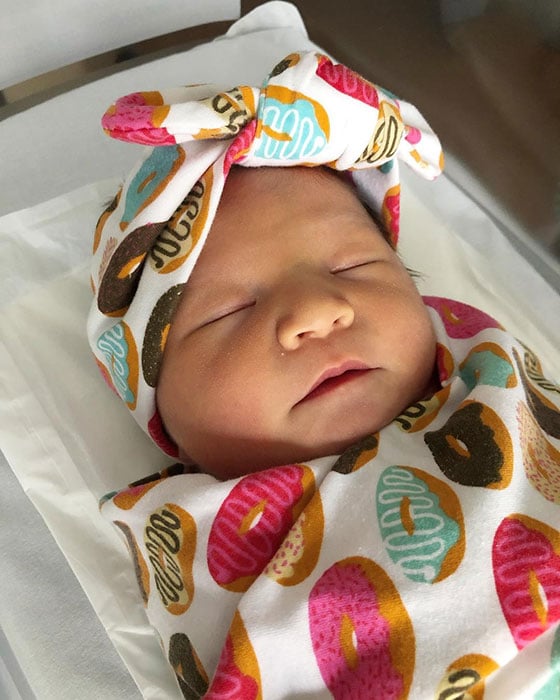
- Average fetal length at 39 weeks: 18.75 inches
- Average fetal weight at 39 weeks: 7.5 pounds
Baby can now be considered full-term! Even though its body hasn’t had much room to grow the last few weeks, its brain hasn’t stopped: it’s grown 30% over the last four weeks! Instead of a pink hue, the skin is likely white or pale gray (regardless of race), but the normal pigment will show up soon after birth. Also, the baby’s tear ducts haven’t opened up yet to produce tears when it cries (and won’t until about a month after birth), so don’t think those cries are fake! A crying baby is always in need of something, even if it’s just to be held.
Pregnancy Week 39 Symptoms & Baby Bumps
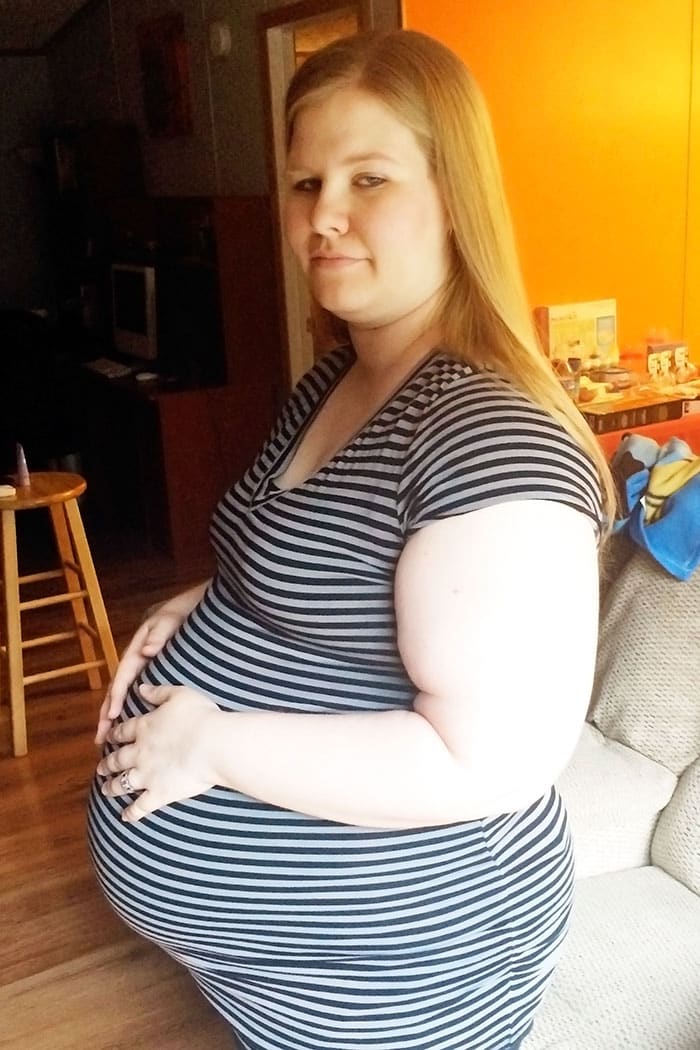
That’s the last bump photo I took before I had my daughter, even though she was born at 40 weeks and 3 days. You can see in my face how OVER being pregnant I was!

Watch out for water flowing out of your vagina, especially if you know you didn’t just pee because dang it, you didn’t even sneeze! This could be your water breaking, which is when the amniotic sac breaks and the fluid rushes out. When this happens, your risk of infection increases greatly so should call your doctor and head straight to the hospital, even if you don’t feel any contractions yet.
An important thing to remember, though, is most women don’t have a dramatic water-breaking moment before delivery (only about 10% of women do). It’s often a slow trickle (if anything) and a “gush” may only occur while you’re already in labor and preparing to deliver.
Your doctor is checking for effacement now, which is the softening and thinning of the cervix that allows it to dilate.
Continuing symptoms:
- food cravings
- heartburn
- gas
- vaginal discharge
- dizziness
- increased OR decreased sex drive
- varicose veins
- round ligament pain
- increased mucus and oil production
- sensitive gums
- forgetfulness
- stretch marks
- backaches
- leg cramps
- swelling
- fast-growing hair and nails
- Braxton-Hicks contractions
- skin discoloration
- altered vision
- hemorrhoids
- insomnia
- fatigue
- leaky breasts
- frequent urination
- nesting
- diarrhea
Pregnancy Week 39 Video
Pregnancy Week 40 Development
How many months pregnant is 40 weeks?
40 weeks equals nine months pregnant! If you’re counting the days, you’ve been pregnant 280 days now (266 of those being after fertilization; the first 14 were your period and ovulation).
Where is the baby located at 40 weeks?
Mama, if the baby isn’t locked and loaded by this point, I’ve got nothing left for you. If the baby is head-up, you’re likely headed to a c-section. If the baby hasn’t dropped, your end result might be the same. But you know what? That’s okay. In fact, it’s better to have an idea of what’s coming and be able to prepare for it.
I had exactly three hours’ notice that I was going to have a c-section with my first baby after an ultrasound revealed she was running out of amniotic fluid and on the hefty side. Let me tell you, that was NOT enough time to mentally prepare, let alone read up or watch videos on what to expect with a c-section! Don’t leave yourself in the dark just because you think it won’t happen to you. Prepare for all scenarios.
What does a baby look like at 40 weeks?
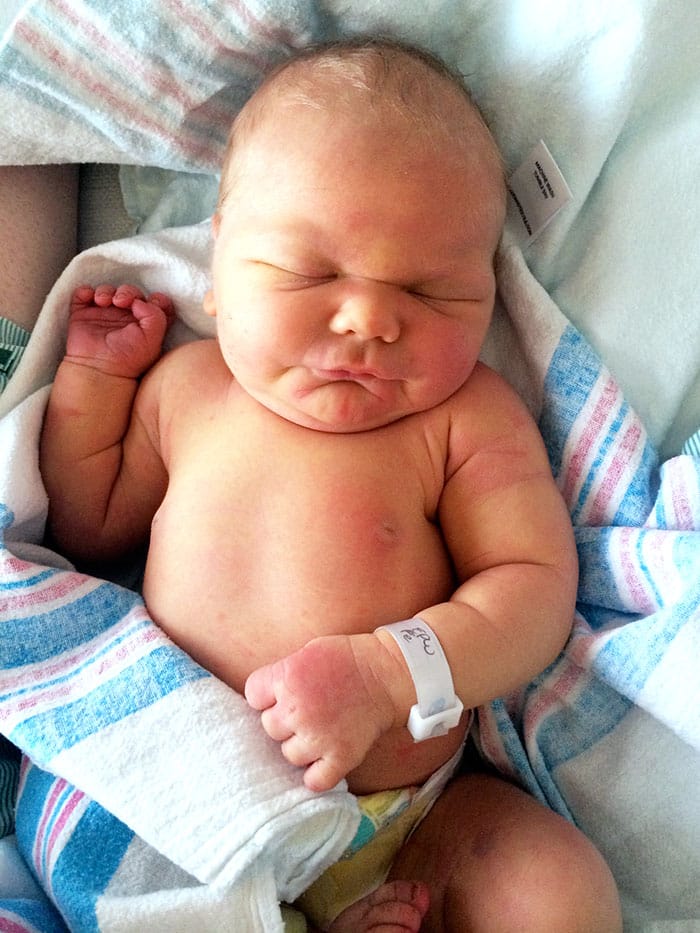
- Average fetal length at 40 weeks: 19.5 inches
- Average fetal weight at 40 weeks: 8 pounds
Since most of the vernix has been shed from the baby’s body, you may find patches of dry skin once the baby’s cleaned off. I recommend eczema-friendly baby lotion to help keep the skin moisturized. Many babies are born with eczema symptoms that disappear over time, though some hang onto it for many years.
My son felt like a lizard within four weeks of being born – rough and scaly from his shoulders to his toes. We used Eucerin several times a day all over and it finally disappeared, but we had to continue it after every bath for almost a year or it would return.
Pregnancy Week 40 Symptoms & Baby Bump
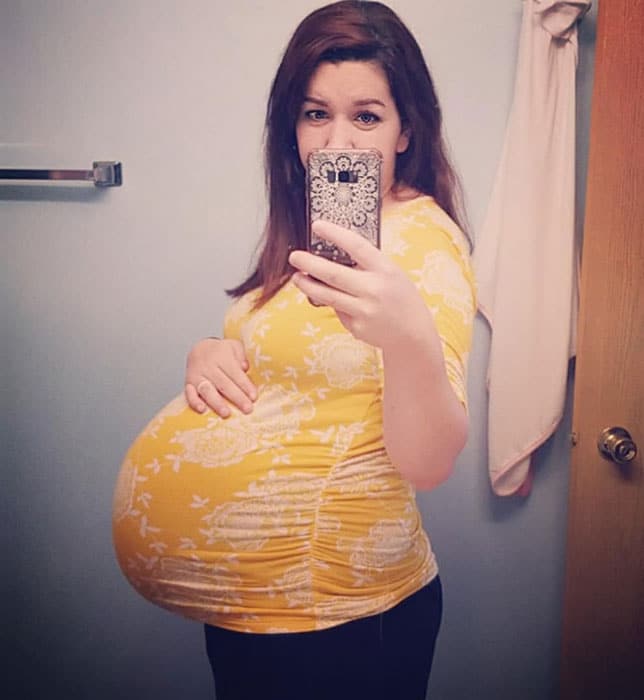
With any luck, you’ll have relief from most of your symptoms soon – and a baby in your arms! If you do start leaking amniotic fluid and it has a green or brown hue, your doctor will need to know ASAP. This is a sign baby has pooped in the womb (a substance called meconium, which is more like dark, sticky tar than the poop you’re familiar with). If this is the case, more precautions will need to be taken during delivery to prevent the baby from breathing it in.
Continuing symptoms:
- food cravings
- heartburn
- gas
- vaginal discharge
- dizziness
- increased OR decreased sex drive
- varicose veins
- round ligament pain
- increased mucus and oil production
- sensitive gums
- forgetfulness
- stretch marks
- backaches
- leg cramps
- swelling
- fast-growing hair and nails
- Braxton-Hicks contractions
- skin discoloration
- altered vision
- hemorrhoids
- insomnia
- fatigue
- leaky breasts
- frequent urination
- nesting
- diarrhea
- effacement of the cervix
Pregnancy Week 40 Video
Pregnancy Week 41 Development
How many months pregnant is 41 weeks?
41 weeks equals over nine months pregnant – and bless your heart!
Where is the baby located at 41 weeks?
Baby’s not making big moves anymore (and probably hasn’t dramatically shifted position for a few weeks now). But I bet you’re wishing the baby would just HURRY UP AND GET OUT FOR THE LOVE OF PIZZA!
What does a baby look like at 41 weeks?
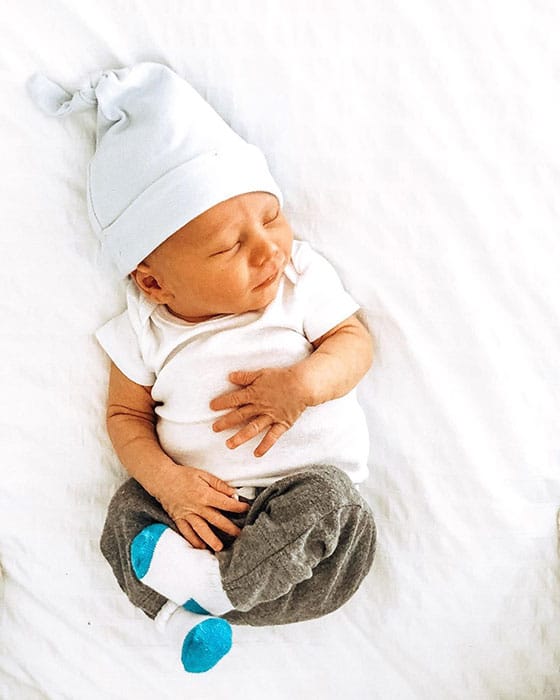
- Average fetal length at 41 weeks: 20 inches
- Average fetal weight at 41 weeks: 8.25 pounds
If the baby’s still hanging in there, those little fingernails have grown to a decent length by now. Make sure to take infant fingernail clippers to the hospital!
Pregnancy Week 41 Symptoms & Baby Bump
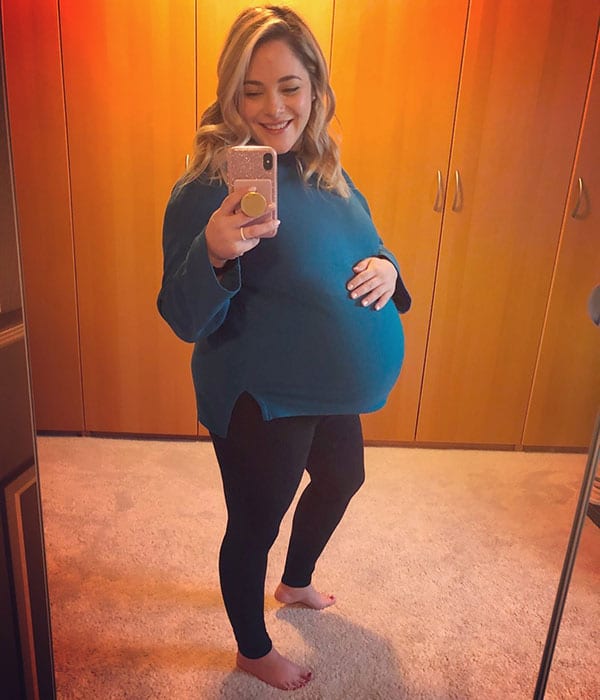
You may experience weight loss once you reach full term, even as the baby is packing on a little more fat. This is due to your body ridding itself of anything not necessary for childbirth, such as extra fluid and poop. You may find yourself suddenly peeing and pooping all the time, or even sweating more than usual. You should also prepare to sweat a lot during the first week after the baby’s born – a lot of your remaining retained fluid will be leaving your body, and keeping the baby close for breastfeeding will have you heating up as well!
I wore as little as possible during the first few weeks (to the embarrassment of many family members), especially while trying to breastfeed. It helped keep me cool, allowed for more skin-to-skin bonding, and made breastfeeding attempts that much quicker and easier for the baby.
Continuing symptoms:
- food cravings
- heartburn
- gas
- vaginal discharge
- dizziness
- increased OR decreased sex drive
- varicose veins
- round ligament pain
- increased mucus and oil production
- sensitive gums
- forgetfulness
- stretch marks
- backaches
- leg cramps
- swelling
- fast-growing hair and nails
- Braxton-Hicks contractions
- skin discoloration
- altered vision
- hemorrhoids
- insomnia
- fatigue
- leaky breasts
- frequent urination
- nesting
- diarrhea
- effacement of the cervix
Pregnancy Week 41 Video
Pregnancy Week 42 Development
How many months pregnant is 42 weeks?
42 weeks equals over nine months pregnant! But don’t worry, if you’ve made it this far, it should be your last week for SURE!
Where is the baby located at 42 weeks?
If the baby’s still inside your uterus at 42 weeks, then congratulations, mama – you are TEN times the woman I am! My longest stint was 40 weeks and 3 days pregnant. As terrified as I was of each c-section, I’d have been begging for one by 42 weeks! Whether you do end up delivering vaginally or have to forcefully evict your little moocher, I’d say this is probably your last week being pregnant… if that’s any consolation to your cankles.
What does a baby look like at 42 weeks?
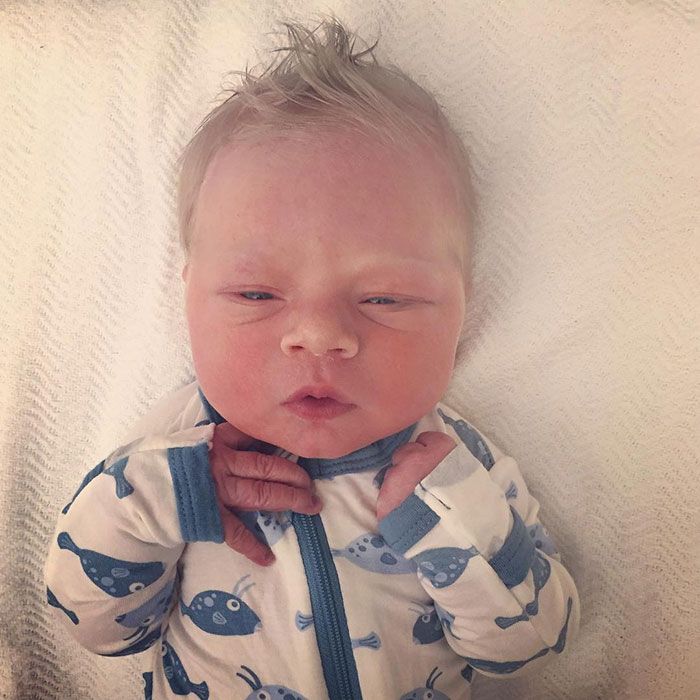
- Average fetal length at 42 weeks: 21 inches
- Average fetal weight at 42 weeks: 8.5 pounds
Baby’s probably just as ready as you are to come out, now; there’s no room left to do anything! The skin is probably very dry and wrinkled now, and may even be peeling at birth, but it’s nothing a good slathering of baby lotion can’t cure. There’s probably a decent head of hair on that noggin now! The placenta may actually be on the decline now, delivering less oxygen and nutrients to the baby than it should be getting, so it’s time to discuss induction with your doctor.
Pregnancy Week 42 Symptoms & Baby Bump

Still being pregnant is actually a sign of something unexpected: an incorrectly estimated due date. Yes, some women really do have babies growing in their wombs for 40 actual weeks (remember, there’s not actually a baby in weeks 1 and 2). But it’s not impossible that your original due date was wrong, especially if you aren’t 100% sure what day you conceived (or even what the first day of your last period was).
While that can be disappointing, it’s better to keep the baby cooking for as long as it actually needs to be! Your doctor should be keeping a close watch to make sure the baby’s not in distress until it’s ready to come out – and incorrect due date or not, it’s probably time to kick the baby out. So congrats, mamas! You did it!
Please share these articles with any expecting friends and family.


